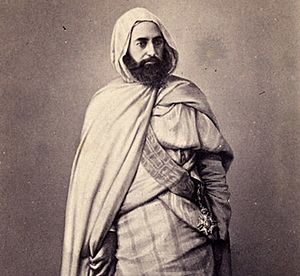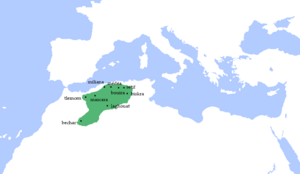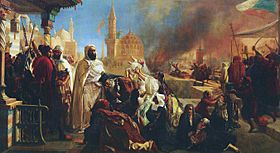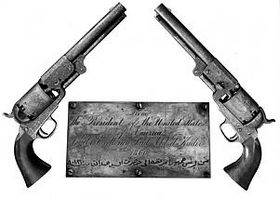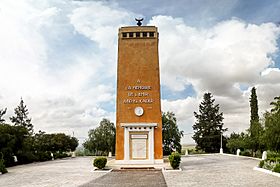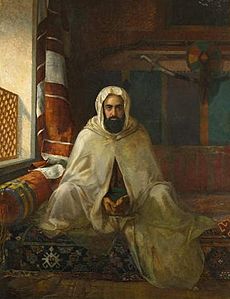Emir Abdelkader facts for kids
Quick facts for kids
Emir
Abdelkader El Djezaïri
عـبـد الـقـادر الـجـزائـري |
|
|---|---|
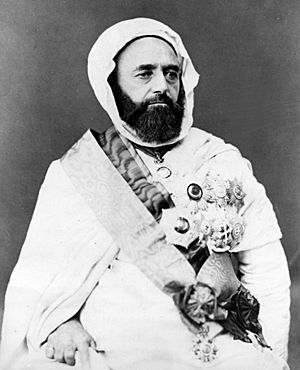
Photographed by Étienne Carjat in 1865
|
|
| Native name |
عبد القادر ابن محي الدين
|
| Birth name | Abdelkader ibn Muhieddine al-Hasani- |
| Born | 6 September 1808 Guetna, Regency of Algiers |
| Died | 26 May 1883 (aged 74) Damascus, Ottoman Syria |
| Buried |
El Alia Cemetery
|
| Rank | Emir |
| Battles/wars | Battle of Macta Battle of Sig Battle of Sidi-Brahim Battle of Oued Aslaf Battle of Agueddin |
| Awards | Legion of Honour (Grand Cross) Order of Pius IX First Class of the Order of the Medjidie Order of the Redeemer (Grand Cross) |
Abdelkader ibn Muhieddine (born September 6, 1808 – died May 26, 1883), also known as the Emir Abdelkader, was an important Algerian leader. He was a religious scholar and a military hero. In the early 1800s, he led a brave fight against the French invasion of Algeria.
Abdelkader brought together many Algerian tribes. For years, they fought successfully against one of Europe's strongest armies. He was known for treating his enemies with respect and kindness. This was unusual for his time. In 1860, he even saved many Christians in Damascus from a terrible attack. Because of this, he received awards from all over the world. In Algeria, he is seen as a national hero. He is remembered for uniting his country and for being both a spiritual and political leader.
Contents
Who Was Abdelkader?
The name "Abdelkader" can be spelled in different ways, like "ʻAbd al-Qādir". People often call him the Emir Abdelkader. The word Emir means "commander" or "prince". "Ibn Muhieddine" means "son of Muhieddine". This shows his family connection.
Early Life and Education
Abdelkader was born on September 6, 1808, in el Guetna, a town in Mascara. He came from a very religious family. His father, Muhieddine al-Hasani, was a respected religious leader. His family also claimed to be descendants of the Prophet Muhammad. This made Abdelkader a sharif, a title of honor.
He grew up learning about religion, law, and language. He was a very smart student. By age 14, he had memorized the entire Quran, which is the holy book of Islam. This earned him the title of ḥāfiẓ. A year later, he went to Oran for more studies. He was a great speaker and wrote many essays about how Islamic law could fit into modern society.
In 1825, when he was a young man, he went on the Hajj. This is a special pilgrimage to Mecca. He also traveled to Damascus and Baghdad. These journeys made his religious beliefs even stronger. On his way back to Algeria, he was impressed by the changes happening in Egypt. He returned home just before the French arrived in Algeria.
Fighting the French Invasion
First Battles and Treaties (1830–1837)
In 1830, France invaded Algeria. The French wanted to take control from the Ottoman Empire. Many Algerians were unhappy with the Ottomans. At first, they could not stop the French. When the French army reached Oran in 1831, Abdelkader's father was asked to lead the fight. Both he and Abdelkader joined the early attacks.
Abdelkader quickly became a leader. In 1832, the western tribes chose him as their "Emir" (commander). He united the tribes and brought safety to the region. His influence grew to cover the whole Province of Oran. The French commander, General Louis Alexis Desmichels, saw Abdelkader as the main leader. In 1834, they signed the Desmichels Treaty. This treaty gave Abdelkader almost full control of Oran Province. This agreement helped Abdelkader become even more respected by both Algerians and the French.
Abdelkader used this treaty to expand his rule. He took control of areas like Chelif, Miliana, and Médéa. The French government was not happy with the treaty. They replaced General Desmichels. This led to more fighting. In July 1834, Abdelkader's warriors defeated the French at the Battle of Macta.
France then sent more soldiers. The French won some battles, but many in France questioned the war. In 1837, General Thomas Robert Bugeaud was sent to make peace. After long talks, they signed the Treaty of Tafna on May 30, 1837. This treaty gave Abdelkader even more land in Algeria. He gained control of all of Oran Province and parts of Titteri.
Building a New Nation
The peace after the Treaty of Tafna helped both sides. Emir Abdelkader used this time to build a new state. Its capital was Tagdemt. He focused on his spiritual authority rather than just political power. He even refused the title of "sultan". His new state was based on religious principles. Many important positions were held by religious leaders. The money used was called the muhammadiyya, named after the Prophet.
He expanded his rule south into the Sahara. Then he moved east to the Chelif valley. By the end of 1838, his rule reached Kabylie in the east and Biskra in the south. It also extended to the Moroccan border. He continued to fight against groups that opposed him.
Abdelkader was good at finding talented people, no matter where they came from. He hired Jews and Christians to help build his nation. He had a standing army of 2,000 men. Local tribes also sent volunteers. He built storage places and workshops in towns. Here, he kept goods to sell for weapons from England. He lived simply in a tent. He taught his people to live carefully. Through education, he taught them about being a nation and being independent.
The End of the Nation
The peace ended when the Duc d'Orléans broke the treaty. He led an army through the Iron Gates. On October 15, 1839, Abdelkader attacked the French. They were trying to settle the Plains of Mitidja. Abdelkader defeated them. France officially declared war again on November 18, 1839. The fighting continued until General Thomas Robert Bugeaud returned to Algeria in 1841. This time, Bugeaud used very different tactics.
Abdelkader was very good at guerrilla warfare. For a decade, he won many battles. He often made short peace deals with the French, but they never lasted. His main strength was in western Algeria. There, he united the tribes against the French. He was known for his honorable behavior. Once, he released French prisoners because he did not have enough food to feed them. During this time, Abdelkader showed strong leadership. He was a good administrator and a powerful speaker. His deep faith in Islam was clear to everyone.
Until 1842, Abdelkader was winning. But Marshal Bugeaud learned to fight back using similar tactics. Abdelkader's light infantry would strike fast and disappear. The French armies became more mobile. The French also used a scorched earth policy. They destroyed crops and homes to make people starve. This forced them to leave Abdelkader. By 1841, his forts were destroyed. He had to move around the Oran area. In 1842, he lost control of Tlemcen. His communication lines with Morocco were cut. He crossed into Morocco for a short break. But the French defeated the Moroccans at the Battle of Isly. Abdelkader left Morocco. He continued to fight the French, winning the Battle of Sidi-Brahim.
Surrender
Abdelkader was eventually forced to surrender. He did not get enough support from the eastern tribes. Also, the King of Morocco, Abd al-Rahman of Morocco, made it illegal for the Emir to be in his kingdom. This happened after the 1844 Treaty of Tangiers.
Abd al-Rahman secretly sent soldiers to attack Abdelkader. They wanted to destroy his supplies. Six months later, Abdelkader defeated these Moroccan forces. An assassin was sent to kill Emir Abdelkader. But when the assassin saw Abdelkader, he dropped his dagger. He said he saw a "halo of the Prophet" around Abdelkader's head. Later, Moroccan armies attacked Abdelkader again. They were defeated in several battles. Abdelkader then decided to leave Morocco and enter French territory to talk about peace.
On December 23, 1847, Abdelkader surrendered to General Louis Juchault de Lamoricière. He was promised he could go to Alexandria or Acre. Two days later, his surrender was made official. He gave his war-horse to the French Governor-General, Henri d'Orléans. However, the French government did not keep its promise. Abdelkader was sent to France and kept prisoner. He was not allowed to go to the East.
Imprisonment and Exile
Abdelkader, his family, and his followers were held in France. First, they were at Fort Lamalgue, then at Pau. In November 1848, they were moved to the château of Amboise. The castle was damp, and many of them became sick. People started to feel sorry for Abdelkader. Famous figures like Victor Hugo spoke out for him. There was also pressure from other countries. Lord Londonderry visited Abdelkader. He then asked the French President, Louis-Napoléon Bonaparte, to release him.
Louis-Napoleon Bonaparte became president in 1848. He wanted to change some policies of the old government. Releasing Abdelkader was one of these changes. On October 16, 1852, Abdelkader was set free. He was given money each year. He promised never to cause trouble in Algeria again. He first lived in Bursa, Turkey. In 1855, he moved to Damascus. There, he focused on religious studies and writing. He wrote a book about philosophy and another about the Arabian horse.
While in Syria, Abdelkader also became a Freemason. He was friends with French thinkers. He also became friends with Jane Digby and the famous explorers Richard and Isabel Burton.
Saving Christians in Damascus (1860)
In July 1860, fighting between different groups in Mount Lebanon spread to Damascus. Local groups attacked the Christian area. Over 3,000 people were killed. Abdelkader had already warned the French consul that violence was coming. When the attacks began, he bravely protected many Christians. He sheltered leaders of foreign consulates and religious groups in his home. He sent his oldest sons into the streets. They offered protection to any Christians in danger. Many survivors said Abdelkader played a key role in saving their lives.
After the riots, reports praised Abdelkader's actions. He received many international honors. The French government increased his pension. They gave him the Grand Cross of the Légion d'honneur. He also received awards from Greece, the Vatican, and Turkey. Abraham Lincoln sent him a pair of special pistols. Great Britain sent him a gold-decorated shotgun. In France, he went from being an enemy to a "friend of France" because he helped Christians.
In 1865, he visited Paris at the invitation of Napoleon III. He was welcomed with great respect. In 1871, there was a rebellion in Algeria. One of Abdelkader's sons tried to stir up tribes. Abdelkader publicly disowned his son.
Death and Burial
Abdelkader died in Damascus on May 26, 1883. He was buried near the great Sufi scholar ibn Arabi in Damascus.
In 1965, his body was moved to the El Alia Cemetery in Algiers. This move was debated by some. Abdelkader had clearly wanted to be buried in Damascus with his teacher, ibn Arabi.
Legacy and Admiration
From the very start, Abdelkader was admired by people in Algeria and in Europe. Even while fighting the French, he showed great kindness. He treated his prisoners-of-war with "generous concern". He also respected their religious beliefs. This was very rare in wars at that time.
In 1843, a French leader named Jean-de-Dieu Soult said Abdelkader was one of the three greatest living men. The other two were also Muslim leaders.
The town of Elkader, Iowa in the United States is named after Abdelkader. The town's founders were impressed by his fight against French rule. They chose his name for their new settlement in 1846.
In 2013, the American film director Oliver Stone announced a movie about Abdelkader. It would be called The Emir Abd el-Kader.
The Abd el-Kader Fellowship is a special program at the University of Virginia. It supports advanced studies.
In 2022, a French statue of Emir Abdelkader was damaged in Amboise, France. This happened during a time of political debate about immigration and Islam.
See also
 In Spanish: Abd al-Qádir para niños
In Spanish: Abd al-Qádir para niños
- Invasion of Algiers in 1830
- Emir Mustapha
- Reghaïa attack (1837)
- Expedition of the Col des Beni Aïcha (1837)
- First Battle of Boudouaou (1837)
- Mokrani Revolt
- French Algeria


